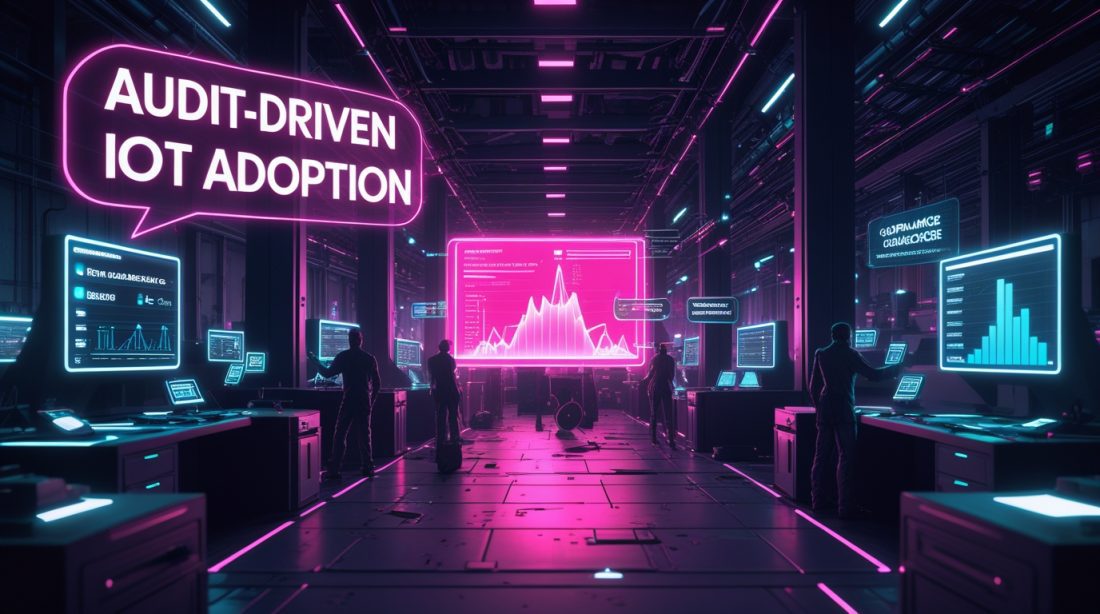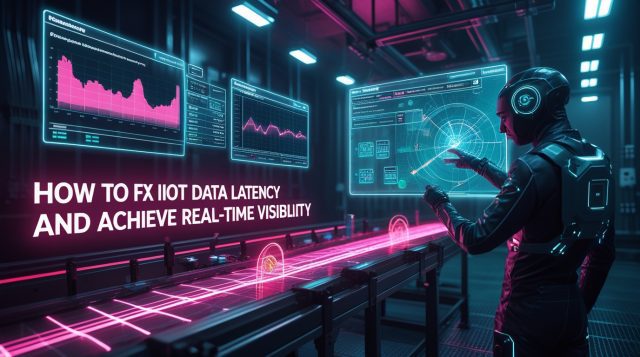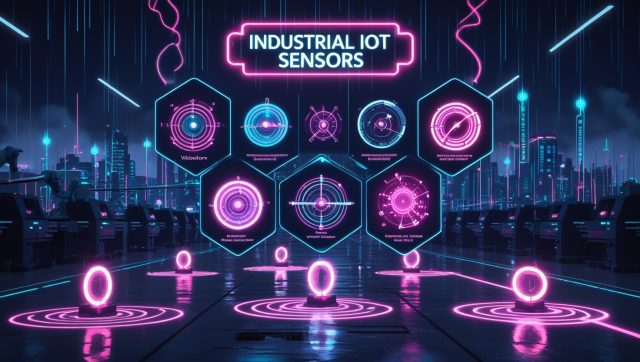Fast Facts
Audit-driven IIoT adoption often spikes during audits because companies use connected technologies to demonstrate compliance with regulatory requirements and industry standards. However, this adoption frequently drops immediately after audits due to a focus on short-term compliance rather than operational value, a lack of sustainable data foundations, and insufficient organizational trust in the systems. Research shows that while 78% of manufacturers invest significantly in smart technologies, only about 25% successfully scale AI/ML solutions across multiple facilities, revealing a fundamental gap between demonstration projects and sustainable implementation.
The audit-driven IIoT paradox
Imagine a major industrial facility scrambling to install sensors and monitoring systems weeks before a regulatory audit. The implementation happens at lightning speed, dashboards glow with real-time data during the audit, and executives breathe sighs of relief when compliance is confirmed. Yet within weeks, the systems go dark – the IIoT initiative declared “successful” but ultimately abandoned. This pattern repeats across industries, creating a cyclical pattern of investment without transformation.
Industry data reveals this isn’t an isolated phenomenon. According to recent manufacturing surveys, while 95% of enterprise GenAI initiatives show no measurable P&L impact, external partnerships are deployed 2x more often than internal builds – evidence that companies struggle with sustainable technology adoption . This article analyzes why this audit-driven adoption pattern persists and how industrial organizations can escape this costly cycle.
Why IIoT adoption spikes during audits
The compliance imperative
Audits create unavoidable pressure points that demand demonstrable evidence of operational controls and compliance. In these high-stakes environments, IIoT solutions offer the quickest path to visible compliance:
- Regulatory requirements: Standards like IEC 62443 for industrial cybersecurity and NIS2 directives in Europe mandate specific security controls and reporting capabilities that IIoT platforms can quickly demonstrate . These regulations are driving specific technical requirements for encrypted communication, user authentication, and secure firmware updates that manufacturers feel pressured to show during audit cycles.
- Safety and environmental compliance: Industrial safety markets incorporating IoT technology are expected to reach $8.9 billion by 2030, growing at 6.3% annually, reflecting increasing regulatory pressure . During safety audits, companies deploy IIoT-connected safety sensors and emergency shutdown systems as tangible proof of compliance.
- Data reporting demands: Modern audits require extensive data collection and reporting capabilities that manual systems cannot provide. IIoT systems can generate immediate evidence of monitoring and control across distributed assets .
The demonstration effect
During audits, visibility becomes the primary currency. IIoT platforms offer impressive visual demonstrations of control and monitoring that satisfy auditor expectations:
- Real-time dashboards: Live data feeds from connected devices create compelling evidence of operational oversight that static reports cannot match. One Cognite client used their industrial AI platform to immediately contextualize problems, diagnose root causes, and initiate corrective actions during operational audits .
- Documented processes: IIoT systems automatically generate audit trails and compliance documentation, reducing the manual effort required for audit preparation. This automation addresses the finding that “human-in-the-loop is still heavy” for many industrial documentation processes .
Why IIoT adoption drops after audits
The ‘checklist mentality’ problem
When organizations treat IIoT implementation as a compliance checkbox rather than an operational necessity, they create what Deloitte’s 2025 Smart Manufacturing Survey identifies as the “GenAI Divide” in manufacturing – where “adoption is high; transformational impact is low” . This mentality manifests in several ways:
- Minimal viable implementation: Companies deploy just enough technology to pass audit requirements without integrating systems into daily workflows. This approach aligns with the finding that only ~5% of task-specific AI tools reach production despite widespread experimentation .
- Departmental rather than organizational adoption: IIoT projects remain confined to compliance or IT departments rather than being embraced by operational teams who would benefit from them long-term.
- Budget cycles aligned to audit schedules: Investment in IIoT capabilities becomes tied to audit cycles rather than continuous improvement roadmaps, creating what one industry observer called “project amnesia” – the pattern of restarting similar initiatives every audit cycle.
The trust deficit
Perhaps the most significant barrier to sustained adoption is the lack of trust in IIoT systems and their data. As noted in analysis from IIoT World, “to scale from experimental to scaled AI requires accurate, contextual, and trustworthy data” – a foundation many companies lack :
- Data quality issues: When IIoT systems generate recommendations based on poor-quality or incomplete data, engineers quickly lose confidence and revert to familiar manual methods. In manufacturing environments, most data originates from documents, CAD files, SOPs, and inspection logs – if these inputs are messy or inconsistent, downstream AI will stall .
- Black box perception: Without transparent explanations for recommendations or predictions, operational teams view IIoT outputs with skepticism. This aligns with the finding that output quality concerns represent a top barrier to AI adoption in industrial settings .
- Technical debt from rapid deployment: The rushed implementations before audits often create fragile systems that require heroic maintenance, further eroding trust in the technology’s reliability.
The foundational gap
Sustainable IIoT adoption requires robust data, organizational, and technical foundations that audit-driven implementations often skip:
- Data governance gaps: According to industry analysis, scaling IIoT across multiple facilities “requires a repeatable playbook, standardizing how data is structured, reusable templates, and lowering the barrier to onboarding”. Without this foundation, each audit triggers another round of point solutions.
- Workflow integration challenges: Systems implemented for audit demonstrations often aren’t integrated into core operational workflows, creating separate rather than embedded capabilities. As Cognite’s Impact 2025 conference highlighted, the future of industrial operations requires AI to be embedded directly into workflows where it can “highlight causality, surface actionable insights, and allow organizations to avoid unnecessary maintenance or downtime”.
- Skills and knowledge gaps: Modern industrial connectivity solutions must bridge the divide between traditional OT systems and the skills of newer engineers who may be “experienced with cloud platforms, cybersecurity, and AI, but less familiar with legacy technologies”. Without addressing this skills gap, organizations struggle to maintain systems post-audit.
How to break the cycle: building sustainable IIoT adoption
Start with the foundation first
Companies that successfully sustain IIoT adoption focus on data foundations before technology deployments:
- Standardize capture and formats: “Harmonize formats across CAD drawings, inspection logs, SOPs… so you’re not feeding AI a patchwork”. One automotive manufacturer implemented this approach and achieved a 10% PLM efficiency increase, saving millions through fewer delays and errors .
- Validate quality at the source: Use automation to flag missing fields and inconsistencies before they flow downstream. Companies that implement this approach see exceptions trend down and straight-through processing rates increase.
- Enforce governance: Establish clear “access, lineage, accountability so every piece of data has an owner and provenance” . This governance creates the trust foundation necessary for sustained adoption.
Focus on operational value, not just compliance
The most successful industrial AI implementations solve immediate operational problems while simultaneously meeting compliance needs:
- Connect to business outcomes: As one industry expert noted, “measure success in business terms (downtime, changeover speed), not model counts” . For example, Siemens found that companies implementing IoT-enabled predictive maintenance reduced unplanned downtime from 39 hours per month in 2019 to 27 hours in 2024.
- Augment rather than replace human expertise: The most sustainable implementations position AI as what Cognite’s CEO called a “collaborative tool, not a replacement for human skills, intuition, and expertise” . This human-centric approach builds trust and adoption.
- Demonstrate quick wins: One practical approach is what Adlib software recommends as a “90-day, document-first plan” that focuses upstream on transforming documents into validated, governed, AI-ready data. This delivers measurable ROI while building foundation for broader transformation.
Build adoption through co-creation
Sustainable implementation requires involving the people who will use the systems daily:
- Include frontline teams in design: Systems designed without operator input rarely achieve sustainable adoption. As one analysis of industrial AI noted, “engineers, operators, and workers are at the center, empowered by AI to act faster, prevent failures, and make better decisions” in successful implementations.
- Address change management directly: The top barriers to AI adoption aren’t technical but organizational – “change management, lack of executive sponsorship, poor UX, and output quality concerns”. Successful programs address these directly rather than hoping technology will overcome them.
- Develop internal capabilities: Instead of relying entirely on external implementations, build internal expertise through partnerships that transfer knowledge. This addresses the finding that external partnerships are “deployed 2x more often than internal builds,” evidence that collaboration accelerates value.
From compliance to capability
The pattern of audit-driven IIoT adoption represents a significant opportunity cost for industrial companies. While the global industrial IoT market continues growing – valued at $194.4 billion in 2024 and projected to reach $286.3 billion by 2029 – much of this investment may be underleveraged if it continues following the audit-driven pattern.
Breaking this cycle requires recognizing that sustainable IIoT adoption cannot be primarily compliance-driven. Instead, it must be value-driven, solving real operational problems while simultaneously meeting compliance requirements. As one industry observer bluntly stated: “The days of handing employees static, clunky tools isn’t going to cut it. To scale AI, we have to deliver both accuracy and usability”.
The companies that successfully navigate this transition will be those that approach IIoT not as a series of audit-driven projects, but as a continuous capability-building journey that creates both compliance and competitive advantage.
Further Reading & Related Insights
- IIoT Time Series Data Corruption from Power Instability in 2025 → Highlights how fragile deployments often fail under real-world conditions, echoing the risks of rushed, audit-driven IIoT adoption.
- How to Fix IIoT Data Latency and Achieve Real-Time Visibility → Explains the foundational data challenges that undermine trust in IIoT systems post-audit.
- 5 Critical Reasons IT and OT Teams Clash Over IIoT Data Ownership in 2025 → Shows how organizational silos prevent sustainable adoption, reinforcing the “checklist mentality” problem.
- Industrial IoT Platform Driving Emerging Market Growth → Demonstrates how platforms can move beyond compliance to deliver operational value across industries.
- Best Industrial IoT Platform Comparison 2025 Guide → Provides a strategic overview of IIoT solutions, helping organizations choose platforms that avoid short-term, audit-only deployments.



